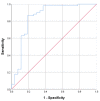A Comprehensive Approach to Predicting the Outcomes of Transsphenoidal Endoscopic Adenomectomy in Patients with Cushing's Disease
- PMID: 35629220
- PMCID: PMC9144911
- DOI: 10.3390/jpm12050798
A Comprehensive Approach to Predicting the Outcomes of Transsphenoidal Endoscopic Adenomectomy in Patients with Cushing's Disease
Abstract
Persistent and recurrent hypercortisolism after transsphenoidal endoscopic surgery (TSS) is considered to be an urgent issue prompting the search for Cushing's disease (CD) remission predictors. The goal was to find a combination of predictors that can forecast the remission of CD after TSS. A total of 101 patients with CD who had undergone TSS were included. One year after surgery, CD remission status was evaluated. Preoperative pituitary magnetic resonance imaging (MRI) data, preoperative results of a high-dose dexamethasone suppression test (HDDST) and morning serum cortisol level collected 24 h after TSS (24 h MSeC) were compared in patients with and without remission of hypercortisolism. Remission one year after TSS was confirmed in 63 patients. CD remission predictors one year after TSS were: adenoma size ≥ 3 mm in the absence of invasive growth and the suppression of serum cortisol ≥ 74% in the HDDST, 24 h MSeC ≤ 388 nmol/L. A total of 38 patients had three favorable values of detected predictors; all of them had CD remission one year after TSS. With long-term follow-up, 36 of them remained in remission. Patients who had no one favorable predictor had no remission of hypercortisolism one year after TSS. Our data confirmed the prospects of using a combination of selected predictors to forecast CD remission after TSS.
Keywords: Cushing’s disease; hypercortisolism; predictors; remission; transsphenoidal surgery.
Conflict of interest statement
The authors declare no conflict of interest.
Figures





References
-
- Arnaldi G., Angeli A., Atkinson A.B., Bertagna X., Cavagnini F., Chrousos G.P., Fava G.A., Findling J.W., Gaillard R.C., Grossman A.B., et al. Diagnosis and complications of Cushing’s syndrome: A consensus statement. J. Clin. Endocrinol. Metab. 2003;88:5593–5602. doi: 10.1210/jc.2003-030871. - DOI - PubMed
-
- Invitti C., Giraldi F.P., De Martin M., Cavagnini F. The Study Group of the Italian Society of Endocrinology on the Pathophysiology of the Hypotalamic-Pituitary-Adrenal Axis Diagnosis and Management of Cushing’s syndrome: Results of an Italian Multicentre Study. J. Clin. Endocrinol. Metab. 1999;84:440–448. doi: 10.1210/jcem.84.2.5465. - DOI - PubMed
LinkOut - more resources
Full Text Sources

